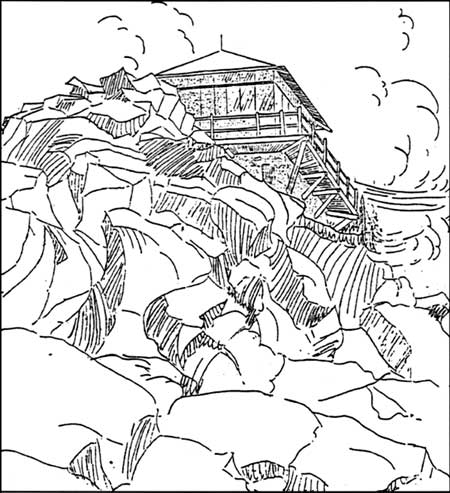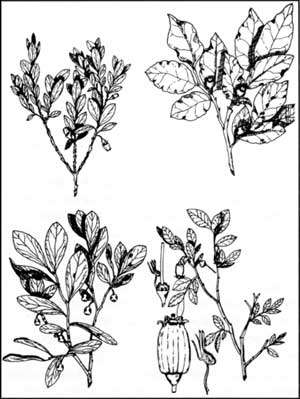Huckleberries
Delicious wild fruit has never been cited as the primary, or even a secondary, reason for why people come to Crater Lake. Few of them know that the park contains four species of huckleberries, and are aware of the lone exception to rules prohibiting collection of plant material in Crater Lake National Park. Each person is allowed one quart of huckleberries per day for personal use, largely because picking does not appear to interfere with perpetuating the host shrub. Bears will forage for ripe huckleberries (as I found out one afternoon in the Sky Lakes Wilderness south of Crater Lake), but this inclination has yet to bring them into conflict with human visitors to the park.
All four huckleberry species are in the genus Vaccinium, which belongs to the Ericaceae(heath) family. This group of plants is distributed worldwide and contains roughly 3,300 species in 103 genera. Most thrive, as the family name suggests, on uncultivated land with inferior drainage. This is usually where the soil is poor, often coarse, and sometimes acidic.
The swamp huckleberry, V. occidentale, likes the western border of the park where it forms dense thickets along streams. It is also known as the westernbog blueberry, since western North American “huckleberries” are really blueberries. (True huckleberries are classed in the genus Gaylussachia, a group much more prevalent in Europe than in the United States). In any event, this plant yields tasty bluish-black berries which usually ripen by early August. They can be had in easily accessible areas such as Boundary Spring, Sphagnum Bog, and Red Blanket Creek.
Bluish-black berries can also be seen on the dwarf or mat huckleberry, V. caespitosum.These shrubs are less than a foot high, with most only a few inches off the ground. They are found in many places around the park, but are probably most evident in the Castle Crest Wildflower Garden, Vidae Falls, Annie Spring, and Wheeler Creek.
The broom huckleberry, V. scoparium, is also known as grouseberry. Some North American Indian groups call it fireberry due to the color of the fruits. This plant possesses bright red berries which are edible and sweet, though usually too small for picking in any quantity. Being the most drought-tolerant species in the genus, it is abundant in lodgepole (Pinus contorta) and mountain hemlock (Tsuga mertensiana)forests throughout the park.
What is certain to be the most sought-after member of the genus, V. membranaceum,goes by several common names. It is variously known as the big, thinleaf, or mountain huckleberry, as well as Ewam to speakers of the Klamath language. This shrub, which is between two and five feet in height, appears as widely branched bushes containing thin leaves that usually measure over an inch long. Its berries are reddish- to purplish-black when they ripen during the first half of August. There are patches southwest of Park Headquarters, but most pickers go to an old burn area on Huckleberry Mountain(Ewamcan in Klamath) in the Rogue River National Forest where more sunlight has enhanced flowering and fruiting.
A visit to Huckleberry Mountain can be combined with a trip to see Crater Lake because it is located less than three miles west of the park boundary. Follow posted signs from the snowpark located on Highway 62 to a primitive campground situated within the huckleberry patches. The bushes cover a relatively broad area, so you will have plenty of options for where to spend a couple of hours picking berries. After a couple of afternoons there last August, I remembered that Henry David Thoreau once quoted Pliny in describing huckleberries, In minimis Natura praestat, Nature excels in the least things. Anyone who has tasted the fruit from Huckleberry Mountain will agree, especially if they are fortunate enough to savor it in pie, jam, or pancakes!
The author would like to thank Joy Mastrogiuseppe for reviewing this article and her suggestions.
Steve Mark has worked as park historian at Crater Lake and Oregon Caves since 1988.

The Watchman Lookout as depicted in the July 1933 Nature Notes from Crater Lake.


